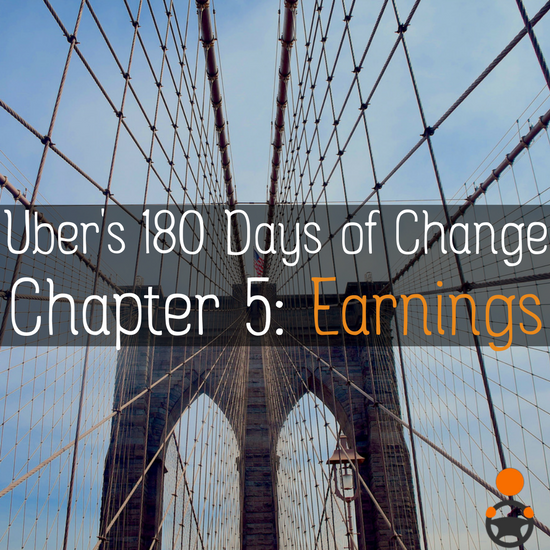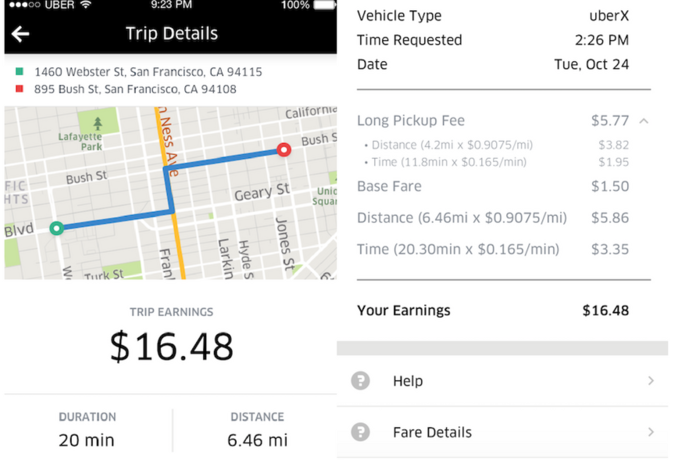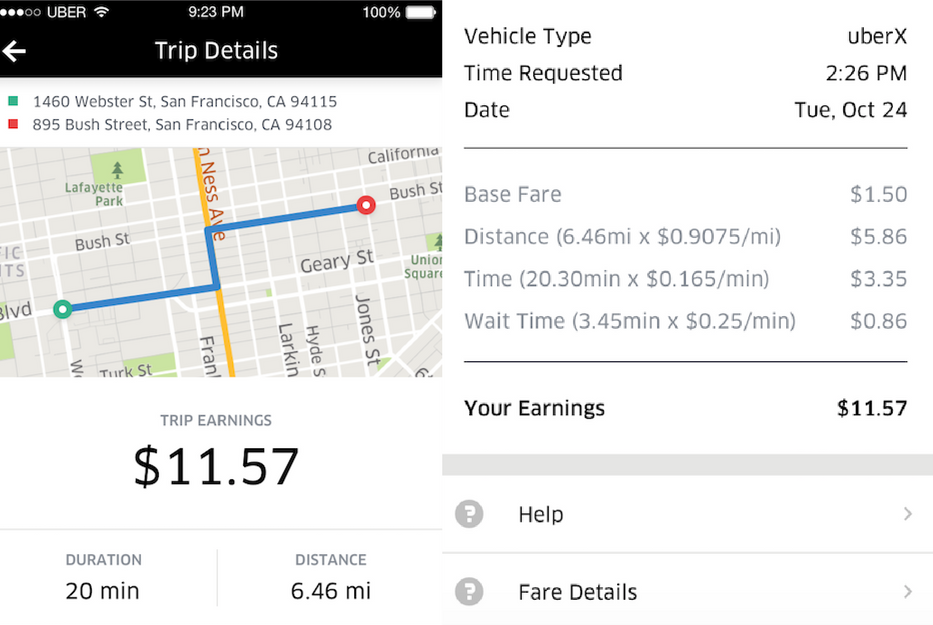Accepting a request with a high ETA is always a gamble, since you never know if a passenger is going to be headed down the block for a minimum fare or to the airport for $50. And since drivers aren’t paid until they arrive and start the trip, a lot of savvy drivers know it’s usually not worth the time/money to drive 20 minutes to pick up a rider for an average fare. That may be changing though.
Today, Uber released Chapter 5 of their 180 Days of Change Program, focused again on earnings. Chapter 5 aims to address the problem of long pick-ups, cancellations on long pick-ups, low wait time rates and a better system for tolls.
One of my major criticisms of Uber’s 180 Days campaign is that they haven’t raised rates, but they have been making some smaller changes to help drivers earn more money, and this chapter definitely expands upon that feature set. So while it may not be as eye-catching as Chapter 1 where they announced a tipping option for drivers, it should still improve the overall experience. The real question though is how much of a difference will it make and how soon will drivers notice the impact?
You can catch up all the news around Uber’s 180 Days of Change program here.
Increased Earnings on Long Pickup Requests
According to Uber,
Drivers will start earning standard time and distance rates after a period of time on their way to the longest pickups in your area. They’ll earn this long pickup fee in addition to their standard trip fare
On a normal UberX trip, you’re only compensated once you arrive and physically swipe to start the trip or once 2 minutes has elapsed and you start earning the waiting time rates (see below). So it’s important that you minimize unpaid miles, like when you’re driving to a passenger, since you don’t receive compensation for the time/mileage.
Example: During a recent week of driving in Los Angeles, I spent about 20% of my time driving to passengers (unpaid mileage/time), 15% of my time waiting for a request (unpaid time) and 65% of my time with a passenger in the car (paid mileage/time).
These percentages will obviously vary depending on when and where you drive, but Uber has told us that this new feature will affect around 10% of your pick-ups. The threshold for ‘long pick-ups’ will depend on the city, but for most major markets (like Los Angeles, San Francisco, Boston, etc) it should be around 8-9 minutes. So if you get a request that’s longer than 8-9 minutes, you’ll be compensated after that threshold. Let’s go over an example from Uber:
You’re a driver in SF and you get a request that’s 20 minutes away and your ‘long pickup threshold’ is 8 minutes. You accept the request and start driving towards the passenger’s location. After 8 minutes of unpaid mileage/time, you start earning the ‘Long Pickup Fee’. You drive an additional 4.2 miles and 11.8 minutes to the passenger’s location for which you receive regular UberX rates of $0.9075/mile and $0.165/min.
You then start the trip and give a ride lasting 20.30 min and 6.46 miles paid the regular UberX rates of $0.9075/mile and $0.165/min plus a base fare of $1.50.
So your total earnings should look like this:
The feature is going live on October 23, 2017 in the following markets: Honolulu, New Jersey, New Orleans, Austin, Milwaukee, and Fort Collins. It will be available in all United States Uber Cities by the end of December 2017. And the new rules only apply to UberX and UberPOOL.
Analysis: I like this feature and it’s one that I’ve been calling for for a while, so it’s good to see that Uber is still listening to drivers and making changes based off the feedback they’re hearing. Passengers care first and foremost about getting a ride and although most rides are centralized in core areas, this feature will make drivers much more willing to pick-up passengers in more suburban areas where ETAs are always longer.
But in the short term, I think this feature is mainly going to benefit drivers in smaller cities or more suburban areas since 8-9 min ETAs just aren’t that common in bigger cities or the core area of Los Angeles for example. There are definitely times when you’ll get a ride out to the suburbs but at that point, most drivers just want to get back into the city where it’s busy and especially if they’re on a trip incentive bonus or earnings boost. So unless you have a destination filter to spare, it may not be worth it to pick up a ride that isn’t headed back to busy areas.
In the long term though, this feature should make Uber way more reliable in the suburbs and in turn mean there may be more longer rides originating from suburbs since the service will become even more dependable.
Earn More for Late Cancellations
Uber will be updating their cancellation policy to protect drivers from last minute cancellations on long pickups. So now when a rider cancels, drivers will earn the greater of the standard cancellation fee OR standard time and distance rates for travel towards the pickup location.
Example: Let’s say you get a request that is 20 minutes away and they cancel after 15.05 minutes and 3.5 miles of driving. With this new feature, you’ll actually earn a higher cancellation fee of $5.50 vs. just $3.75 with the old system.
The feature is going live on October 23, 2017 in the following markets:
- Phoenix, Yuma, Flagstaff and Western Arizona
- San Diego and Sacramento
- Philadelphia
- Minneapolis – St. Paul
- San Antonio
- New Jersey
- New Orleans
- St. Louis
- Boston, Worcester and Western MA
- Portland, ME and greater Maine
- New Hampshire
- Burlington
- Maui, Kauai and Big Island
- Lawton
- Las Cruces, Taos, Gallup, Albuquerque and Santa Fe
- Inland Empire
- Reno
It will be available in all United States Uber cities by the end of December 2017.
Analysis: In the past, I would actually call riders whenever there was a 15 min ETA or more and confirm that they were ok with waiting that long since riders sometimes get impatient, so this is definitely a problem for drivers. This new feature should give you confidence to accept those long ETA requests and know that if the passenger cancels, you’ll actually be compensated for all the effort you put in.
Earn Higher Wait Time Rates
I like to tell drivers that you always want your wheels moving when a passenger is in the car since the mileage rate is about 5-6x greater than the per minute rate. Uber recently started charging riders for wait time after drivers have arrived and waited for 2 minutes and it definitely seemed to motivate the more price sensitive passengers to come outside sooner even though the waiting rate was pretty low.
Now, when you arrive and wait two minutes though, Uber is going to start charging a higher wait time rate. In San Francisco, they’ll now charge $0.25/min instead of $0.165/min. So in the example below, you arrived at the passenger’s location, waited 2 minutes of unpaid time and then waited another 3.45 minutes of unpaid time before the passenger came out and started the trip.
Analysis: Drivers definitely need to be paid more for wait times, since if you think about it on an hourly basis, 16.5 cents a minute is only $9.90 per hour, which is actually way below the San Francisco city minimum wage of $14 per hour. The new rates will be slightly higher and in SF, the hourly rate grows to $15 per hour, so it’s definitely a start.
I’m sure we could argue over what the right amount would be, but I think something around minimum wage makes sense since you’re really just sitting there. Obviously if it was for an entire hour, it would hurt your earnings but if it’s only a few minutes here and there, I think that’s reasonable.
The higher wait time rates only apply before you start a trip though. Once the trip starts, normal per minute rates apply, even if the passenger wants to make a stop. In the future, it would be nice to see an increased wait time rate apply to stops while on a trip and while sitting in traffic.
Smarter Tolls
According to Uber,
Drivers shouldn’t have to pay tolls when they’re on the way to pick up a rider. We’ll soon incorporate tolls into your fares, and we’ve updated our technology to avoid matching drivers with a rider on the other side of a toll.
I don’t have a ton of experience with tolls since I’m based in Los Angeles, but I know it’s a big problem for drivers in other parts of the country. This is really more of a technology update so there isn’t a feature that you’ll see in the app but on the request side, you should expect less problems with tolls.
The new technology is already live across the United States and Canada and will apply to all rides on UberX, UberPOOL and UberBLACK.
More Work, More Money
Drivers haven’t always been rewarded for the effort they put into the platform, but a lot of the changes we’re seeing as part of the 180 Days of Change are clearly aiming to fix that. In the past, riders were getting a great deal since a lot of drivers would go out of their way to accommodate a long ETA or wait an absurd amount of time for them to come outside and it was frustrating. But the nice thing about a lot of these changes is that they encourage good behavior from all parties and they make the platform more equitable.
These new features will no doubt improve the driver experience but at the same time, they don’t address the core issue of drivers wanting higher rates. And while there are a lot of factors that go into a driver’s pay, mileage rates have always been the gauge by which drivers measure Uber’s commitment. Most drivers are thinking about their earnings on a weekly, daily or even single trip basis so while long pickups sounds great in theory, how will this actually affect my earnings? Will I make $50 more per week or 50 cents? I don’t know..
Uber’s in a groove right now and making lots of positive changes to the driver experience but they need to find a way to show drivers in dollars and cents how the experience is improving.
Drivers, what do you think about Uber’s latest feature additions? Will they have a large impact on the driver experience or do you just want higher rates?
-Harry @ RSG








